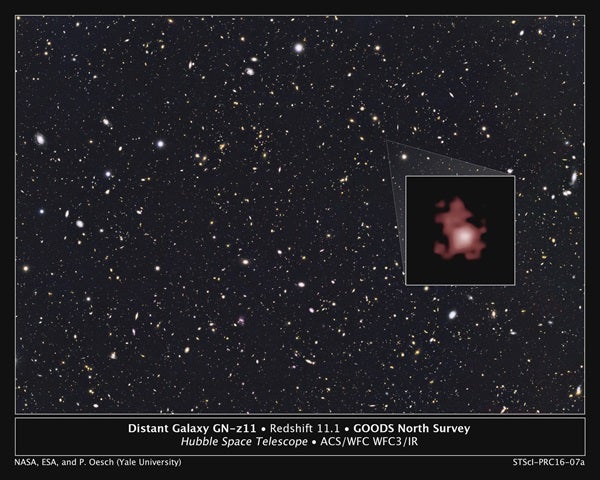Our deepest astrophotos show ultra-distant quasars and galaxies whose redshifts indicate their light has traveled for nearly 13 billion years. Thus, they are 13 billion light-years away, right? And that must define the edge of the visible universe, right?
It’s a widely repeated “fact.” There’s even a plaque in the Rose Center for Earth and Space in New York City that flat-out declares the radius of the visible universe to be 13 billion light-years.
But that figure only tells us how long an object’s light has been traveling. It’s not the end of the story, because ever since a given galaxy emitted the light we’re now seeing, it’s been zooming away from us. Today that galaxy is 46 billion light-years distant.
This should make our heads spin. How could anything reach a distance of 46 billion light-years in the mere 13 billion years since it emitted the light we now see? That would mean it’s currently receding faster than light. Or that space is so warped we’re not viewing it directly.
Actually, both are true. Faster-than-light recession doesn’t violate relativity in this case because the galaxy’s mass was never accelerated. It’s merely the intervening empty space between galaxies that has been wildly inflating, which makes the real radius of the observable universe very nearly 46 billion light-years. Light from objects any farther away will never get here because space’s expansion will stretch out, hopelessly weaken, and out-race their rays. So, it’s a real boundary beyond which there is eternal blankness. We use the term visible universe for everything nearer, which is everything we can ever possibly know about.
Given the average density of space — five atoms per cubic yard (1 cubic meter) — the visible universe must contain 1056 tons of matter. And 1084 photons of light. It’s a hefty universe.
But what about the universe beyond the part we can see? The real universe? How big is the whole thing?
There’s no sign that galaxy clusters get any sparser as we approach the edge of the observable universe. A 2012 study led by Shirley Ho, then at the Lawrence Berkeley National Laboratory, charted 900,000 galaxies to show that the topology of the visible universe is perfectly flat, which means stuff keeps abundantly going on beyond the visible boundary.
One theory, using the most plausible figures for when the era of inflation began just after the Big Bang, concludes that the overall universe is 300 billion trillion times larger than the visible universe.
But it’s also possible the real universe is infinite. If that’s true, galaxies go on and on without end. Ho told me that their results do indeed permit an infinite universe. But because you can never prove infinity, it’ll remain an open question.
If the 2012 results are wrong, then a much different scenario is also on the table. Before those data, in fact, it seemed that the real cosmos could even be smaller than the visible universe!
Huh? Could you imagine how that could even be possible?
Well, back in the ’90s on my monthly page in Discover magazine, I mentioned that in an unbounded finite universe, the bending of space-time along its circumference would permit galaxy light to circle around. Thus, we earthly observers could see a second image of a nearby galaxy. That duplicate observation would be of the galaxy’s far side after its light had circled the cosmos. It would probably be unrecognizable as the same object, since we’d be seeing it in the distant past, at an earlier stage of its evolution. But if there’s a bunch of such duplicates out there, then the cosmos is smaller than it seems.
We started out asking a simple question and ended up nauseated. Now you know why I prefer observing beloved lunar craters like Copernicus and Eratosthenes. They’re 50 miles (80 kilometers) wide, a known distance away, and none of that is ever going to change.










